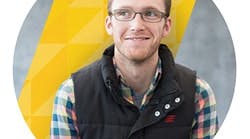Automation projects: Getting buy-in through greater visibility
John Tertin is director of sales and marketing for ESE Inc., a food & beverage plant automation and engineering firm. For this month’s edition of Automation Zone, Tertin and his colleague Erik Winer, facility modernization consultant for ESE Inc., spoke with Plant Services chief editor Thomas Wilk about how to facilitate important group discussions on plant automation.
Erik Winer
PS: Tell me about what your term "Growing into Greatness" means in terms of what you do and the kind of customers you serve.
JT: It starts with the notion of continuous improvement. A lot of our customers have aspirations of being able to grow their businesses and product lines, increasing yields, and improving operator safety and quality attributes of their products. Frequently, though, they don’t have a good road map of how to get there.
Control systems and production environments themselves are getting more and more complicated, and customers recognize that there’s value to be had in things such as leveraging the industrial internet of things, or being able to directly link ERP and MES systems with the control layer, but are asking “How do I get there? How do I capitalize on some of that value potential that’s out there?”
Part of the complexity is that, as modern systems start bridging gaps between IT and operations, there’s a lot more user groups and stakeholders involved that are not necessarily accustomed to working together. So, being able to bridge that gap and help our customers really “grow into greatness” is a very valuable resource. For some of these user groups, which are really important to have involved in a conversation when you’re talking about a long-term strategic plan to grow your production system, these people aren’t used to talking to one another.
From a process side, we can have the same conversation with them. “This is what you stand to gain from a recording standpoint,” as far as recording user interactions and CFR 21 Part 11-type things, and traceability, and get information from the system in terms of reporting. That is best done when you’re working in cooperation with IT.
Once you have credibility with both sides, you can have that more holistic conversation with everybody in the room and not have IT sitting at the left side of the table and engineering sitting on the right, with both constantly filtering conversations because they are uncomfortable.
“Growing into greatness” is attainable regardless of the size of company. It’s not a “rip everything out and replace it” process; it’s an iterative process to help customers grow and get there while keeping their facility running.
PS: Erik, tell me more about your new role of Facility Modernization Consultant.
EW: It’s important for ESE as a controls integrator to offer up this service, and to say to the customer: “Let’s make that road map. Let’s review their current infrastructure and production process and see how it all fits together.” Every single plant is unique, and every single customer is unique, and therefore you should have a unique plan for every customer.
PS: How often do you see maintenance and reliability join these teams? Is that something you advocate, or do you bring them in at a certain point in the process?
EW: I think a lot of times, if an integrator’s walking into a facility, they’ll often overlook the people in the facility that have to maintain, or who are going to actually be taking care of this equipment or operating the equipment. When we walk into a facility, it’s critical that we not only talk with people that work on the projects, but then also with people that have to manage the equipment. It’s our goal to basically talk with everyone, because everyone’s got a different perspective and everyone is impacted by change.
John Tertin
PS: What are you seeing with your customers, with your partners, on whether cybersecurity is a wedge that can be used to start these projects and help get a facility digitalized and modernized?
JT: That’s definitely part of the discussion. During the facilitation this comes up pretty frequently. Regardless of whether they have internal engineering capability, the operations folks heavily rely on outside resources to be able to maintain their control systems. So, the conversation ends up happening because, whether IT knows it or not, a significant portion of facilities out there are going to have some way of being able to support outside contractors. And frequently, IT isn’t aware of it, because the operational folks are just trying to get the job done and trying to keep the facility running and be able to reach out to those external resources when they need to.
From our experience, it isn’t predominantly an intellectual property type of risk. That’s not what’s first and foremost on customers’ minds. It’s a means of access control and being able to, really, have visibility and access control over, “What outside people am I allowing onto my network?” However, part of that is intellectual property, part of that is ensuring that we do have traceability of activities when we have people that are coming in and tinkering with really important, critical systems from a production standpoint.
It’s the hypothetical border-wall discussion. You can put up a wall. People are going to go over it. People are going to go under it. So, enterprise IT is constantly being undermined because you have operations folks trying to keep the lights on and the machines running that are putting in devices that IT is unaware of.
IT is accountable for not allowing outside resources in, but they’re not empowered to be able to do that and they don’t have visibility into what is actually occurring. It’s a stressful position for someone in IT who’s accountable for maintaining that access control to do so when their systems are not being leveraged to provide that external access.
PS: We hear often that the technology problems can be solved over time, but people problems are much more difficult because it's harder to get that sense of teamwork and change to set. Do you find any specific approach to building that sort of teamwork that works?
EW: Part of the approach that we take in the consultation actually tries to push toward more of that teamwork. Everybody has a different interaction with their facility, a different mindset, or opinions on how things work or what should be upgraded. You might not get the same answers from a maintenance manager as you would from someone that’s signing checks up in an office somewhere. It’s really important that as we do an assessment, as we do that consultation with a customer, that we’re actually talking with each group or each area within the facility. Then, at the end of the assessment, we can come back and say, “OK, from a holistic view, this is what we’ve seen. These people have these issues. This is where we could possibly see some more system efficiencies.”
It’s like putting a flashlight in an area where someone can’t see. We can say to someone that’s signing checks, for example, “Maintenance might have already brought this to you, but this is actually a valid concern, because if you were to upgrade this, you could increase efficiencies, or you could reduce operator downtime.” A lot of times, by this assessment, we’re bringing the teams closer together because they’re realizing more information about their facility that they might not know.
PS: The implication is that if someone comes up from the outside, you can listen to all the concerns and pinpoint the one or two that matter most, even if the other side, a different party, doesn't really know it.
This article is part of our monthly Automation Zone column. Read more from our monthly Automation Zone series.
EW: Yeah, and sometimes someone might have this great idea, like an Ethernet infrastructure upgrade, which is great, as a lot of times, older facilities really could use an Ethernet infrastructure upgrade. However, it might not be the right decision at the time. There might be four or five steps that need to be done prior to doing that upgrade, and that might not be visible to everyone within the company.
JT: It really boils down, ultimately, to that credibility, and the ability to have a team of people that are available to a customer to really garner their respect at the onset. Being able to really level with the IT folks is really important. On the production side, we’re dedicated to the food and beverage industry to the exclusion of all others, and we’ve seen so much of a broad spectrum of processes within that industry that we’re able to really garner that respect from the production side as well. So, when you do that on both sides, you’re really able to bring people together.



